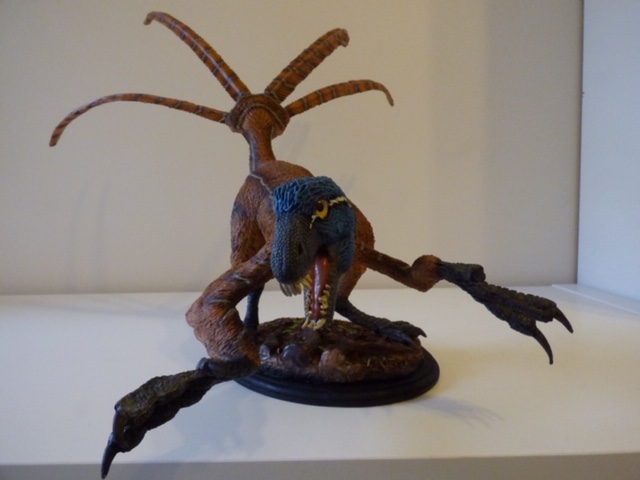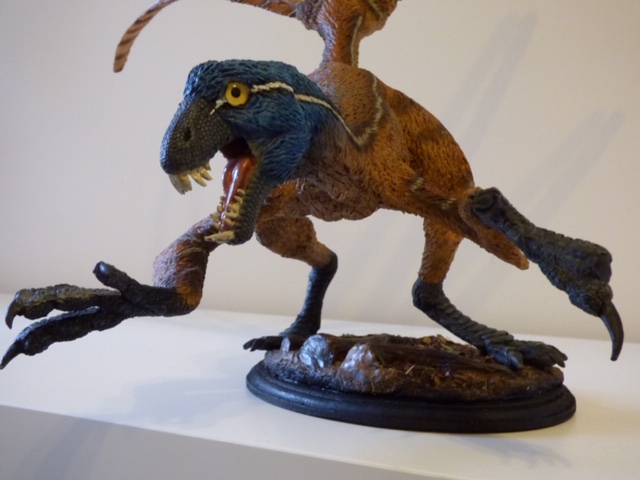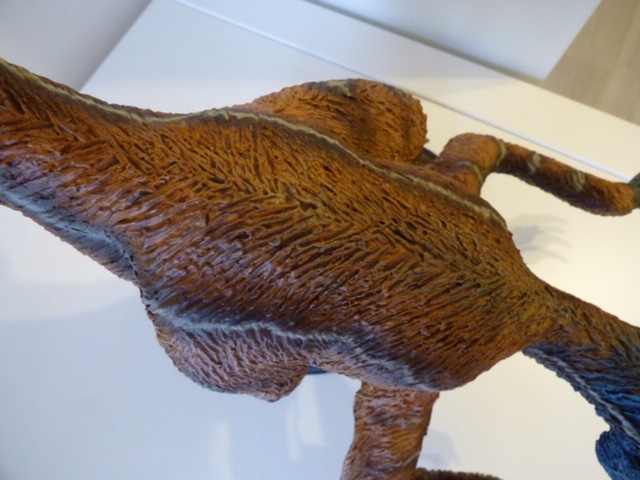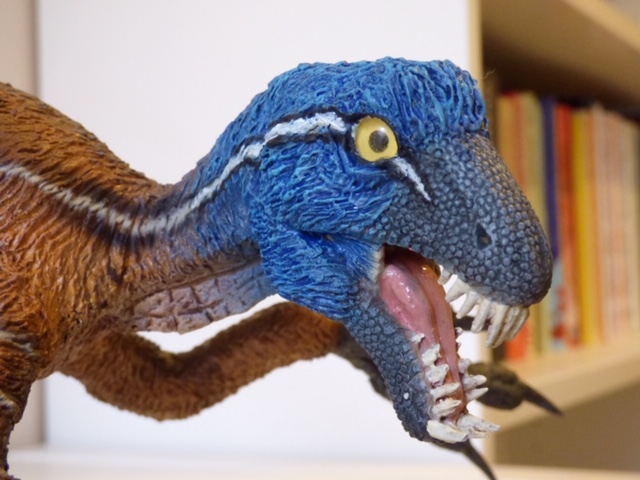Review and photographs by K. Bela, edited by Suspsy
“We’re living through the golden age of dinosaur discoveries.”
That was the first sentence spoken by the late and great John Hurt in the well-known 2011 BBC series Planet Dinosaur. The line haven’t lost its meaning since. Paleontologists literally dig up a new dinosaur fossil every week. Last week, Pablo Gallina published his discovery of a new dicraeosaurid sauropod from Argentina, Bajadasaurus pronuspinax. A few days ago, the Nemegt Desert provided a new oviraptorid, Gobiraptor minutus. Last December, Cristiano Dal Sasso described the oldest ceratosaur known to us, Saltriovenator zanellai. And did I mention Crittendenceratops krzyzanowskii from the USA? Or Weewarrasaurus pobeni from Australia? The South African sauropodomorph Ledumahadi mafube? Of course, there is one of my favourites, Caihong juji with its iridescent feathers. And I could go on.
As science gives us more and more amazing dinosaurs to read about and admire, we have to talk about those who try to bring them even closer to us. The illustrators, the sculptors, and the animators. They use the known evidence to give these marvellous creatures form, to bring them back to life. Today, I would like to write about one of them and his work. I had the luck to carry on a very fruitful and constructive correspondence with him, which resulted in something truly spectacular and unique. He is the Master of the Dinosaur Dungeon, Jason Carriere. The subject of this review is his Epidexipteryx hui commission model.

Epidexipteryx hui was discovered in China in 2008, which became the new hot spot of revolutionary dinosaur discoveries in the 1990s’. It is estimated to be 160 to 168 million years old, dating itself to the Middle/Upper Jurassic. The fossil is an exquisitely preserved one, embedded in rock and showing a very distinct characteristic: four long tail feathers. In fact, the animal itself was found to be covered in primitive body feathers. These feathers were unsuitable for flying, but the structure and length of the tail feathers suggested that they were used for something else: display. Epidexipteryx hui means “Hu’s display feather.” The body of the animal is 25 cm long, but it could reach 45 cm with its tail feathers. Its skull is also interesting, as it shares similarities with the avialan Sapeornis, oviraptorosaurs and even therizinosauroids. Its dentition is interesting as well, located only in the front of the jaws with unusually long, forward-angling front teeth. A nice, interesting little creature, isn’t it? When I watched the second episode of Planet Dinosaur, I became infatuated with the Epidexipteryx as depicted in it.
I got acquainted with high-end resin dinosaur models in 2017. Many famous and spectacularly big, scary, or strange dinosaurs already have resin representatives (these include Acrocanthosaurus, Allosaurus, Amargasaurus, Ankylosaurus, Parasaurolophus, Styracosaurus, Triceratops, and Tyrannosaurus). However, feathered dinosaurs are somewhat underrepresented, although I did see beautiful feathered Deinonychus, Gorgosaurus, and Therizinosaurus models for sale. But the small feathered critters are very rare. During my quest on the most famous social website, I encountered a company named The Dinosaur Dungeon. Not long after, I found out about the man behind it, Jason Carriere. His Yangchuanosaurus and Wendiceratops models spoke for themselves. From his shared pictures and videos, it was obvious he was a meticulous sculptor, researching the animals and making multiple sketches and pictures about them. Through standard comments, I got to know he takes up commissions. So, in the spring of 2018, I contacted him via email about commissioning an Epidexipteryx model. He was very kind and helpful, and we quickly worked out the details. Soon we established that for the agreed price, he would sculpt a 1:1 scale model. A 25 cm long (okay, 45 cm) Epidexipteryx!

Jason started with scientific research, collecting the available pictures and research materials about the animal. Then, once everything was collected, studied, and read, the work began. Let me praise his work a little more by saying that Jason is a pro in every sense of the word. If he works on something, he does that for many hours each day. He does his utmost to make his sculptures look dynamic and scientifically accurate, and always provides photos about the working process. You can see the long-extinct animal slowly taking form. And when it’s finished, and you see the completed and painted model of yours . . . well, all I can say is that it was worth all the money and time.
The complete model is about 25 cm long without its tail feathers. Once the feathers are attached, it reaches up to 45 cm. And since the animal raises his feathers high up, its total height is 35 cm! With his forelimbs spread wide open, his width reaches 40 cm. Overall, these are the exact dimensions of the once-living animal as well. Epidexipteryx was no bigger than a chicken.

The posture is very dynamic. I think it shows the animal setting its eyes on either a rival or a potential mate. He is taking a step forward with his left hind leg and spreading his feathery forelimbs wide in order to make himself look bigger and scarier. His head is turned to the right, his jaws are opened wide, and his tail feathers are spread–he is really at his game. Angry little creature. But it isn’t surprising. As he is a close relative to the direct ancestors of birds, his behaviour and physical characteristics are prone to be more or less similar to them.

The Epidexipteryx’s colours match his environment. The region he lived in during Jurassic China is considered to have been a vast forest with lush undergrowth and high trees. The base colour is reddish-brown, which is interrupted by two bigger black and white stripes going along the back, while the limbs and tail feathers have similar stripes. Remember, these feathers are not for flying, but for display. So, similar to modern birds, our dinosaur has a very bright and distinct attribute: his head is blue with two longitudinal black and white stripes starting just behind his nostrils, continuing on his head, going along his neck and back, and ending at his tail. His eyes are big, yellow, and radiant.

What else is there to say? If you would like something special, new, or unique, you have to be bold to ask, willing to pay for it, and eager enough to look for the right man to make it for you. I’m glad I found Jason Carriere and contacted him about this commission. Thank you again, Jason, for your work, and I wish you many more succesful and dino-rich years! May the gates of The Dinosaur Dungeon never close!

Support the Dinosaur Toy Blog by making dino-purchases through these links to Ebay and Amazon. Disclaimer: links to Ebay.com and Amazon.com on the The Dinosaur Toy Blog are often affiliate links, when you make purchases through these links we may make a commission

Wow, what an interesting creature!
Great review of this unique and one of a kind model!
Thank you so much for the wonderful review! It means a lot, and I really appreciate it! I’m really glad that you like the piece, and I look forward to hearing what you think of the Therizinosaurus when it arrives in the spring!
It’s a very impressive piece, incredibly lifelike. My only disappointment is the lack of wings. (And the high price but that doesn’t count).
Shouldn’t it have wings like its relative Yi qi?
As I understand, it’s still debated. It has no wing feathers, but it may had a membrane similar to Yi qi.
A very impressive piece indeed! I especially like the head.
Thank you so much!